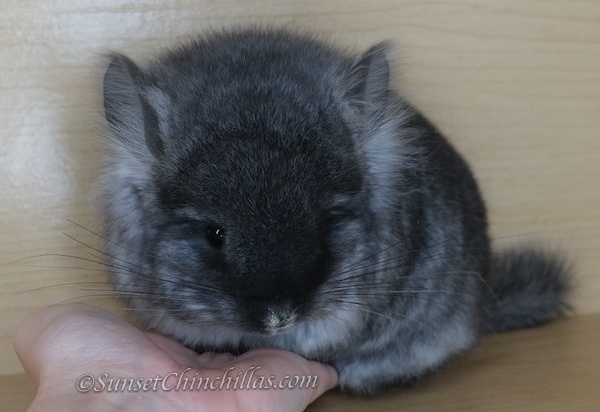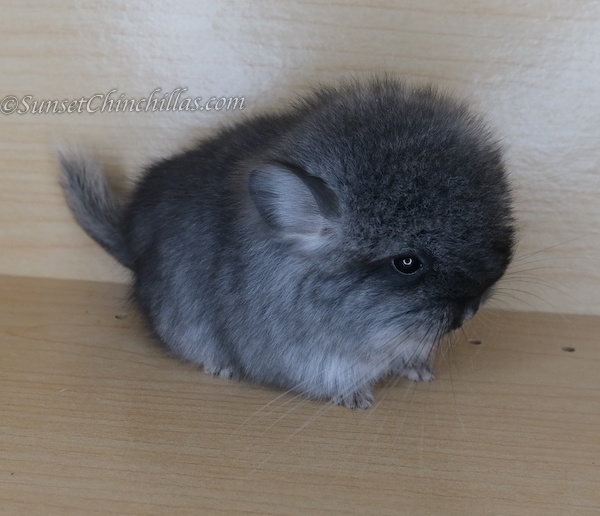Angora Chinchilla | Royal Persian Angora (RPA) Chinchilla | Extra fluffy Chinchilla
Angora refers to any chinchilla that has longer than average fur. Average fur is defined between 3/4" - 1.25" in length. My regular chinchillas tend to be closer to 3/4 for ease of maintenance.
The angora/long furred gene is considered recessive but I've seen it behave like a weakly dominant gene similar to ebony. If you take an Angora to a short furred chinchilla there is a chance you'll get an angora,
I've had it happen here multiple times and I have a very small group I work with. My only focus with angoras is to improve and show, my lines are all carrier x carrier or RPA x regular furred.
I do not breed RPA x RPA as it creates an obscene amount of health issues in a group of chins that is already plagued with health issues. By keeping strictly to carrier x carrier I've managed to avoid all of these so far.
As mentioned above I have also had a number of visible angoras born from RPA x regular chinchillas. As I only have half a dozen in breeding it's surprising that it throws so frequently. This means that the long haired "gene" (actually multiple sets) is weakly dominant.
There are several genes involved, one for fur length of the body, one for length of fur around the ears, one for length of fur around the roach "mane" area and one for tail fur. There is another that appears to change the texture/type of fur on the tail to almost human hair like and makes it very long indeed.
2023 - Seven month old Angora Sister (Top) and Brother (bottom) black velvets. Both took section champion at the Wisconsin show and went up to compete for grand show. I am extremely proud of my lines, every
one that has been shown placed reserve champion or better even in the national shows.
2021 - Six month old Angora chinchilla with extremely long tail hair. He also has unusually long inner ear hair and wiskers, but his body fur is one uniform length.

2021 - Baby Black Velvet Angora, 10 weeks old with very long ear hair and ear tufting starting to show up.
2021 - Angora champion Wisconsin 2021
2019 - Difference between a regular baby chinchilla (left) and an angora baby chinchilla (right) at 3.5 weeks old.
2019 - Baby Ebony Angora chinchilla at 5 weeks old. The long body fur makes them look very poofy indeed.

2020 - Baby Black Velvet Angora, you can not tell if they will develop a mane or ear tufts as a baby.
2021 - Tov Mosaic angora chinchilla, this male took champion in Colorado. He has a very long mane and ear tufts but does not have the long tail fur like my gray line. The mane and ear tufts do not always show up 100% of the time, it is completely random.
Angora Chinchillas for sale - I produce a very limited number of angoras or carriers per year, often only two or three and they are out of the lines pictured here and are full siblings to these.
Updated 6/25/23
I frequently get asked how to breed angora chinchillas so this is how I started; please keep in mind my goals are health, temperament and show quality. If a chinchilla is lacking any of those traits it does not have a place in my program.
2018
Gen 1. 5 year old Mosaic RPA male x proven show class champ pure standard & Black Velvet females - by using an older male I am eliminating the chances of genetic malocclusion and chewing right from the start.
This tiny little mosaic from Hawaii Chinchillas was my first angora in 2018. At 5 years old and only 500g I had a lot of work to do.
Thankfully I had just met some wonderful breeders in Colorado, Maynard and Calista Beitz who had some of the densest and most stunning chinchillas -
I picked the two best females they would let me buy for this project, both proven show but non breeders for Maynard so I was hoping they would produce here, and they did! These became the Mosaic's ladies.
2020
Yep, it took two years to get those ladies producing that second generation. Chinchilla breeding is not fast if you are after improvement.
I needed two outcrosses in this generation to create a robust lineage. I wanted ear tufts so I picked a male from Bobbie's chinchillas that I knew came from parents with the trait. I also wanted manes, thankfully the original Mosaic had that. I did not want long fur for maintenance reasons.
Gen 2. Black Velvet rpac M (from Bobbie's Chinchillas/Russian lines) x Black Velvet rpac F
The male from the Russian lines was so tiny, maybe 550g (first picture) and the gray rpac female from Bobbie wasn't the best but she had good color though no fur density. The black velvet girl out of my first generation (last photo) wes so stunning she took reserve section champion at the Colorado ECBC show.
Gen 2. Tov Mosaic M rpac x Standard rpac F (from Bobbie's Chinchillas, pictured with small black velvet male above)
This is the male out of that same Hawaii Mosaic and MVCR Black velvet pairing, full brother to the velvet. I put Bobbie's gray female with him instead.
2021
Finally back to producing angoras. I had about eight babies born before I ended up with two that had the fur and qualities I was looking for in the next generation.
Gen 3.Tov Mosaic RPA M x pure Standard F
My Tov Mosaic rpac boy knocked it out of the park with a stunning Tov Mosaic Angora boy (first photo is dad and baby) who grew up to take Reserve champion Angora at the MCBA National show in March 2023.
Last photo is the pure standard girl, another Maynard lineage lady that is being used to produce the next generation.
Gen 3. Standard RPA M x pure Mosaic F & pure Standard F
This guy not only ended up with the most stunning gentle and friendly personality but exceptional size as well as took champion angora of show at Colorado ECBC. He has now produced 12 babies with his two girls, a pure standard and a top quality mosaic.
2023
These photos are of 3 to 6 month old guys, but I will include photos of their babies below.
Gen 4. Standard rpac M and mosaic rpac F
Gen 4. Standard rpac M and Mosaic rpac F, Mosaic rpac F
Babies from the above pair (sold)
3 month old baby angora boy, look at that mane and fur tufts! So excited at what these guys are producing.